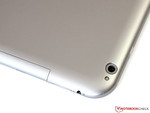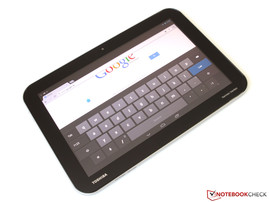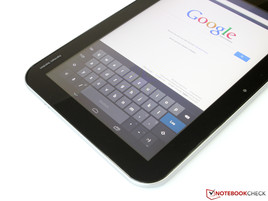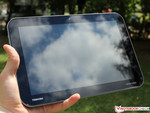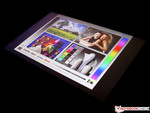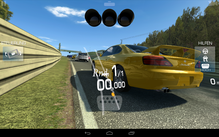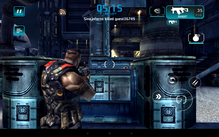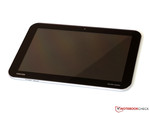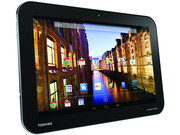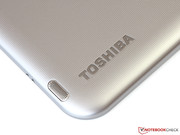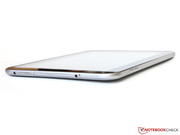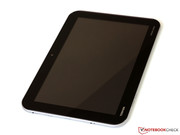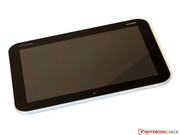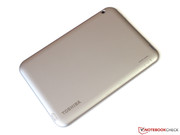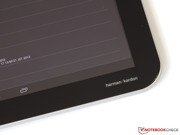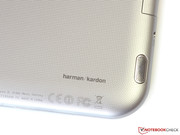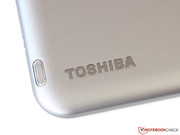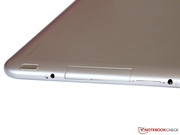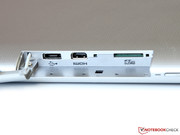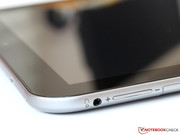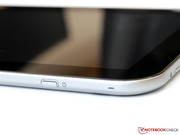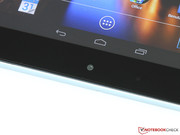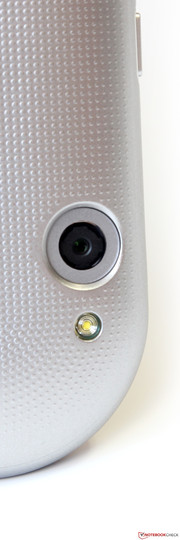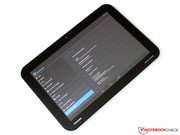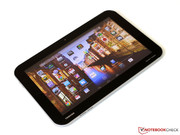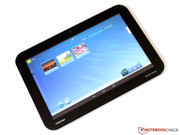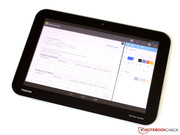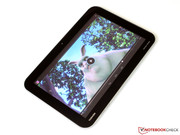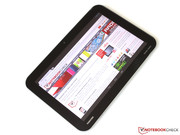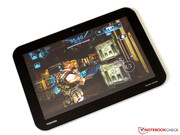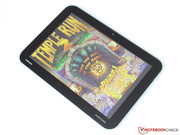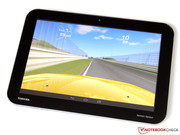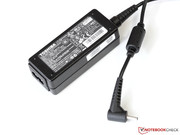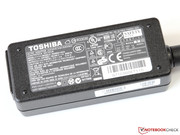Review Toshiba Excite Pro AT10LE-A-108 Tablet

For the original German review, see here.
More than half a year has passed by now since Nvidia introduced the eagerly anticipated Tegra 4 SoC at the CES in January. However the grandly announced chip has not been actually available to date. A circumstance that will not go unpunished in the fast moving and highly competitive ARM business and will probably have cost Nvidia one or two design awards.
With the Toshiba Excite Pro AT10LE there finally is a Tegra 4 device that has found its way to the local dealers. The 10-inch Android tablet is not only supposed to score with its fast quad-core SoC though, but also stands out of the masses in other disciplines: The IPS display has an extremely fine resolution of 2560x1600 pixels, the speakers come from Harman/Kardon and the WLAN module already radios with the latest high-speed standard 802.11 ac.
Considering these qualities, the entry level price of 429 Euros (~$568) for our 16 GB model does not seem overpriced, especially since a doubling of the memory for a surcharge of 20 Euros (~$26) is quite low-priced. For an additional 50 Euros (~$66) the tablet can also be ordered with a practical Bluetooth keyboard cover, which was not at our disposal for this test though. The same goes for the also available "Excite Write" with stylus and optional 3G module.
Given the price and the configuration, the Excite Pro is definitely geared towards the high-end competitors like the Apple iPad 4, the Google Nexus 10, or the Sony Xperia Tablet Z.
Please note: Starting with this review we have revised the valuation standard for virtual keyboards. For all the details click here.
The designers were not given much creative leeway for the layout of the new tablet. Therefore the Toshiba Excite Pro presents itself quite unobtrusively. The outer dimensions (26.1 x 17.9 centimeters) match almost exactly the 10-inch tablets of the competition; only the iPad 4 is slightly differently shaped due to its 4:3 display. Points are deducted for the thickness of 10.5 millimeters though, that let the Excite appear a little cumbersome, especially in comparison to the Xperia Tablet Z (6.9 millimeters). In addition to that the weight is with 630 grams relatively high but still within the acceptable range.
The silver-gray plastic covered back side creates a fitting contrast to the shiny black front side. To improve surface feel as well as grip the manufacturer equipped the surface with a fine point structure, which makes it possible to hold the device even with sweaty hands.
From a qualitative point of view Toshiba's tablet can only partly live up to the expectations of a high-end product. Even though the torsional rigidity is almost perfect, the case can be slightly bent in certain areas - accompanied by creaking sounds of deformation. Despite the proper processing, this discipline is won by the competitors Google and Apple.
Unlike other tablets where the buyer sometimes has to pay outrageous surcharges for more memory capacity, the Toshiba Excite Pro can be easily and inexpensively extended via MicroSD slot. Thanks to SDXC and UHS-I support it is possible to use extremely fast models up to 64 GB of capacity without limitations. The according card reader is hidden under a small flap at the left side of the case, which also holds a Micro USB port as well as a Micro HDMI outlet in store. The latter serves as connector for external monitors or TVs. The USB port allows the use of mass storage devices, input devices (mouse, keyboard, game controller) or LAN adapters.
Software
Those who already own a more or less current Android device should have no problems with the handling of Toshiba's most recent tablet. We could not find any noteworthy differences in comparison to Google's Nexus 10, which is equipped with a "vanilla" version of the operating system. Is this a drawback? Not at all: Without an elaborate modified surface it should be quite easy for Toshiba to offer future OS updates in a relatively timely manner. So much for theory - unfortunately at the date of our review there was no more current version than Android 4.2.1 available.
Only a few of the additional preinstalled apps can really be called useful. A nice extra is the full version of ThinkFree Office 6.0, which is capable of many functions of the Microsoft Office programs Word, Excel and PowerPoint. The network-compatible Toshiba Media Player also turns out to be quite practical, although both tools can also be replaced by freely available alternatives.
Communication
The latest WLAN standard 802.11 ac has already found its way into current high-end smartphones like the Samsung Galaxy S4, but the Excite Pro is the very first tablet. Unfortunately Toshiba does not reveal more than the manufacturer's name Broadcom. It is very likely though, to be the single stream solution BCM4335 with a maximum gross data rate of 433 Mbit/s. Beside the higher speed, the new version also promises improved connection stability - by default 802.11 ac radios in the less frequented 5 GHz band. The tablet handles our test with a common 802.11 n router without any complaints and proved its very steady reception quality. The support of practical features like Miracast (similar to Wireless Display) and Wi-Fi Direct (WLAN connections without a router) is equally pleasant.
Bluetooth 4.0 and a GPS receiver are also integrated. The latter ensures a fast and precise location determination outdoors.
Cameras
As is customary in the upper price segment, the tablet has one camera each on the back and front side at its disposal. A basic 1.3 megapixels webcam with face recognition serves for video chatting. Its highly mediocre picture quality cannot thrill us. In contrast to that stands the main camera with 8.0 megapixels: The 1/3-inch sensor with a fast F2.2 lens takes detailed pictures with vivid colors, especially during daylight. The video recordings are, with their 1080p resolution, also quite impressive. They even thought of an image stabilizer, although it is only a software solution.
Apart from well-known Android 4.2 features like HDR or panorama settings, Toshiba also integrated a so called TruCapture function. It serves to optimize the perspective and contrast of photographed text (e.g. of whiteboards, but also of books or documents) to ensure the best possible legibility. In practice this works quite well, but miracles cannot be expected.
Accessories
The tablet, a 36 watts power supply and some brochures: We could not find more in the packaging. Further accessories like an adapter for the Micro HDMI outlet is widely available on the market with third-party suppliers.
Warranty
In consideration of the high buying price, the short warranty period of just 12 months is inadequate. Toshiba offers at least a free on-site pickup service if the repair was requested via service hotline. However competitor Samsung shows how it is really done: Every tablet comes with a 2 year manufacturer's warranty.
The only pre-installed keyboard is the common Android keyboard as is also the case for the tablets of the Nexus series and many other competitors. Owing to the big keys and the intuitive layout, even beginners can type quickly after a short time of familiarization. Light input is captured exactly by the 10 finger touchscreen and instantaneously converted.
As alternative to the classical typing, the letters can simply be swept over with your fingers ("Swype"), or you fall back on the surprisingly reliable voice input. Naturally it is also possible to obtain other keyboards from the Play Store.
Concerning sharpness and resolution of the display, no other tablet has been able to keep up with the Nexus 10. The Excite Pro is the first to do so: An enormous 2560x1200 pixels are displayed along a diagonal of 10.1-inches. Typical for Android: A little bit is "lost" due to the controls of the system. This results in a pixel density of nearly 300 dpi. The retina pioneer Apple falls back with "only" 264 dpi for the iPad 4 as does Sony's Xperia Tablet Z which only has 224 dpi to offer. Nevertheless it is also quite difficult to detect single pixels of these models.
| |||||||||||||||||||||||||
Brightness Distribution: 85 %
Center on Battery: 329 cd/m²
Contrast: 940:1 (Black: 0.35 cd/m²)
ΔE ColorChecker Calman: 6.73 | ∀{0.5-29.43 Ø4.77}
ΔE Greyscale Calman: 7.99 | ∀{0.09-98 Ø5}
Gamma: 2.23
CCT: 7805 K
The built-in IPS panel scores further with a decent brightness which amounts to a maximum of 306 cd/m². If requested an integrated brightness sensor takes over the control of the backlight. A manual setting is also possible though. Combined with a substantial black value (0.35 cd/m²), the tablet achieves an excellent contrast ratio of 940:1, which significantly improves movie and gaming experiences. No matter if iPad or Nexus: The competition cannot do it better.
The manufacturer should have been a little bit more careful when calibrating the display. With a color temperature of 7805 Kelvin the display is distinctly too cool. Color fidelity (Delta E 6.73) and grayscale representation (Delta E 7.99) can also merely be found at the lower end of the mid-range. Those points of criticism should not be overrated though: Without a chance of direct comparison most users will probably not even notice any difference.
A thin layer of hardened glass ("hardcoating glass") protects the display against scratches and damages, but not against annoying reflections during outdoor use. Despite the substantial background illumination, websites and other text are in particular difficult to read under direct sunlight - a well know problem of almost all current tablets. In the shade the Excite can be used without significant limitations.
Since an IPS panel is even often part of the standard configuration of the lower priced devices, viewing angle stability is as a rule not an issue. Even though colors and contrast slightly lose their intensity from extremely high viewing angles, the screen content remains discernible and most widely undistorted. However OLED displays are just a bit better in this discipline.
For a long time Nvidia's Tegra 3 was one of the most popular tablet SoCs in the mid- and upper-price range. Compared to Qualcomm's Snapdragon series the chip was recently not competitive though. In addition to that, the barely slower but significantly more energy-efficient and cost-effective Cortex-A7 SoCs by MediaTek & Co cannibalized the sales further.
The new Tegra 4 is supposed to catapult Nvidia back to the top of the performance ranking. The four Cortex-A9 cores of the predecessor had to make way for a Cortex-A15 quad-core which not only promises a significantly improved per-MHz performance but also higher clock rates of up to 1.9 GHz (Excite Pro: Tegra T40S, 1.8 GHz). Additionally a so called "companion core" ("4+1") was installed to lower power consumption during periods of low demand. This is another Cortex-A15 whose maximum clock rate has been limited to roughly 800 MHz and its core optimized for lower voltages.
The new graphics unit is barely less impressive than the CPU. Nvidia has sextupled its amount of shader units from 12 to 72, which divide into 24 vertex and 48 pixel shaders. A real unified-shader architecture, as can be found among the competition, will probably not be installed until 2014 with the Tegra 5 ("Logan"). Therefore GPU computing is at least partly denied for the Tegra 4.
The connection to the main memory works via a 2x 32-bit big dual-channel interface, which was equipped by Toshiba with 2 GB DDR3L-1600. The SoC, which was made in TSMC's 28 nanometers HPL process, should have a TDP of about 5 to 6 watts; unfortunately Nvidia doesn't publish official information just like the competition.
Let's start our benchmarks with a variety of various CPU tests. This time the Excite Pro, or to be more precise the Tegra 4, has to compete against other high-end SoCs from Apple (A6X) and Qualcomm (Snapdragon 600 and S4 Pro). On top of that, the Nexus 10 (Exynos 5250), which is also based on the Cortex-A15 architecture, completes the competition, even though it only has two cores.
No matter if Geekbench or Linpack: Nvidia's new miracle weapon ranks with a significant edge first on the performance list in every single test. Despite the fact that the gap varies a little, even the strongest competitor, namely the Samsung Galaxy S4 with a 1.9 GHz S600, can be kept off by 20%. It has to be considered, though, that a tablet offers a much bigger margin for energy-consuming SoCs, which makes this comparison not really fair.
In everyday life, tablets are above all used for one purpose: Browsing the internet. While computers and laptops have already offered enough power reserves for complex websites for years, ARM SoCs have just slowly started to explore this field.
After extensive tests with the preinstalled standard browser Google Chrome, we can establish: The Tegra 4 makes the Toshiba Excite the fastest Android tablet that is currently available on the market - at least until Apple's next iPad or Qualcomm's Snapdragon 800 is available. Whether it is big sites with many pictures or a variety of tabs, the device barely breaks out in a sweat. Smooth zooming and scrolling are still ensured.
Website are even still relatively quickly called up when the energy saving mode, which limits the CPU clock rate to roughly 900 MHz, is activated. Now scrolling causes slight stutters. This could be caused by the high display resolution.
| Sunspider - 0.9.1 Total Score (sort by value) | |
| Toshiba eXcite Pro AT10LE-A-108 | |
| Google Nexus 10 | |
| Apple iPad 4 | |
| Sony Xperia Tablet Z | |
| Samsung Galaxy S4 GT-I9505 | |
| Octane V1 - Total Score (sort by value) | |
| Toshiba eXcite Pro AT10LE-A-108 | |
| Sony Xperia Tablet Z | |
| Samsung Galaxy S4 GT-I9505 | |
| Peacekeeper - --- (sort by value) | |
| Toshiba eXcite Pro AT10LE-A-108 | |
| Google Nexus 10 | |
| Apple iPad 4 | |
| Sony Xperia Tablet Z | |
| Samsung Galaxy S4 GT-I9505 | |
* ... smaller is better
Different from browser benchmarks, where the CPU performance is primarily important, Quadrant and AnTuTu evaluate the performance of the entire system. Once again we obtain a clear picture: More performance is currently not available in the ARM section. Even the Galaxy S4, which has a slightly higher clocking Snapdragon 600, has to acknowledge defeat by a little in both tests.
The built-in flash memory presents itself also as very decent, but not to the same extent that the best competitors can. 10.7 GB of the 16 GB eMMC drive is available for the user's data. It can read at a maximum of 52 MB/s and write at 11 MB/s. This makes the Excite Pro only half as fast in comparison to the Google Nexus 10. Toshiba's tablet reveals another small weakness when writing small 4K data.
| Quadrant Standard Edition 2.0 - --- (sort by value) | |
| Toshiba eXcite Pro AT10LE-A-108 | |
| Google Nexus 10 | |
| Samsung Galaxy S4 GT-I9505 | |
| Sony Xperia Tablet Z | |
| AnTuTu v3 - Total Score (sort by value) | |
| Toshiba eXcite Pro AT10LE-A-108 | |
| Google Nexus 10 | |
| Samsung Galaxy S4 GT-I9505 | |
| Sony Xperia Tablet Z | |
Given the extremely high display resolution, the tablet also needs a respectively fast graphics unit to display games and 3D applications fluently. The GPU of the installed Tegra 4 variant T40S possibly clocks a little beneath the permissible maximum of 672 MHz. However, the theoretical computation power should suffice to still beat most of the other currently available ARM SoCs.
Indeed: With a slight advance Toshiba overtrumps the Mali-T604 of the Nexus 10 as well as the Adreno 320 in the Galaxy S4 and the Xperia Tablet Z in 3DMark and GLBenchmark. The only SoC Toshiba cannot pass is the PowerVR SGX554MP4 of the iPad 4: Owing to the quad-channel interface, the A6X has a third more of memory bandwidth, which is especially worthwhile for graphics applications. This suffices to draw level with the Apple tablet which is not too bad. However, the Tegra 4 shouldn't be a match for the Adreno 330 of the upcoming Snapdragon 800.
| GLBenchmark 2.5 - 1920x1080 Egypt HD Offscreen Fixed Time (sort by value) | |
| Toshiba eXcite Pro AT10LE-A-108 | |
| Google Nexus 10 | |
| Apple iPad 4 | |
| Sony Xperia Tablet Z | |
| Samsung Galaxy S4 GT-I9505 | |
| GFXBench (DX / GLBenchmark) 2.7 - 1920x1080 T-Rex Offscreen (sort by value) | |
| Toshiba eXcite Pro AT10LE-A-108 | |
| Google Nexus 10 | |
| Apple iPad 4 | |
| Sony Xperia Tablet Z | |
| Samsung Galaxy S4 GT-I9505 | |
| 3DMark | |
| 1280x720 Ice Storm Standard Graphics (sort by value) | |
| Toshiba eXcite Pro AT10LE-A-108 | |
| Apple iPad 4 | |
| Sony Xperia Tablet Z | |
| Samsung Galaxy S4 GT-I9505 | |
| 1920x1080 Ice Storm Extreme Graphics (sort by value) | |
| Toshiba eXcite Pro AT10LE-A-108 | |
| Apple iPad 4 | |
| Sony Xperia Tablet Z | |
| Samsung Galaxy S4 GT-I9505 | |
Synthetic benchmarks are one thing, but how does the tablet handle current games from the Android Play Store? Among others we tested Temple Run 2 and Shadowgun, whose complex graphics are smoothly and flawlessly displayed. However, we detected intermittent minor graphic errors in the menu of Real Racing 3. These should not lower the amusement level though. We hope that future system updates also bring the graphics driver up to date to resolve these issues as fast as possible. However, there is still enough power available for the game: By default the Tegra SoC sets the level of detail to the lowest, but the game also runs quite smoothly on the highest level.
Temperature
A slight temperature rise is already detectable during idle or with simple multimedia applications running. The upper left area of the back side reaches with 36 °C the highest temperature - apparently that is where the Tegra chip is situated. In our opinion this is a very unfavorable spot: The right-handers who hold the tablet with the left hand touch the hottest spots of the surface directly with their fingertips. Our advice: Simply hold the Excite Pro upside down. It would have been better though, if Toshiba had placed the SoC in the center of the device.
While the temperature at low load can still be considered bearable, nobody wants to hold the tablet in their hand for longer periods at full load - at least not around the area of the previously mentioned hotspot. The same applies for the competition of this performance range though. Those who choose low temperatures over the best performance should look for a device with a Cortex-A7 SoC.
(+) The maximum temperature on the upper side is 35.9 °C / 97 F, compared to the average of 33.6 °C / 92 F, ranging from 20.7 to 53.2 °C for the class Tablet.
(±) The bottom heats up to a maximum of 41.5 °C / 107 F, compared to the average of 33.2 °C / 92 F
(+) In idle usage, the average temperature for the upper side is 31.4 °C / 89 F, compared to the device average of 30 °C / 86 F.
Throttling and other Abnormalities
Due to the relatively strong heating, we examined if the performance is influenced by throttling. Right after the start this is not yet the case: As an experiment we conducted the 3D benchmarks at 7 °C in a refrigerator but were not able to ascertain any improvements.
When the device is used to the full for longer periods of time - depending on ambient temperature and application this takes only a few minutes - the power value start to decrease continuously. After almost 10 runs of the current 3DMark the initial score of 7,948 points dropped to 3,527 points, which is equivalent to a reduction of more than 50%. Admittedly the test conditions were with an ambient temperature of 25 °C not ideal, but a tablet has to be designed for these conditions as well. Subjectively speaking, we perceived the performance loss during games considerably less dramatic. This could be owed to the fact that a throttled Tegra 4 is still an extremely fast SoC.
However, the stability problems, which we encountered during our test with various applications, are unacceptable. The screen not only froze multiple times during 3D benchmarks, but also while browsing. The only possibility to reactivate the system was by rebooting it. We are in touch with Toshiba to sort out the cause of this behavior.
Speakers
Blaring speakers are a thing of the past: The Excite Pro offers real stereo sound with two 1 watt speakers by Harman/Kardon. Spaciousness, resonance and maximum volume level rank among the best that we have heard from tablets so far - improving music and movie experiences substantially. Over-modulation and clanging are nonexistent even at high volume levels. A Micro HDMI and a common jack socket (3.5 millimeters) with good sound qualities are available when the sound needs to be sent to an external playback device.
Power Consumption
Nvidia's previous SoC, the Tegra 3, was already not renowned for its energy-efficiency. The Tegra 4 seems to carry on this tradition: While measuring an acceptable 2.5 to 6.1 watts during idle, we measure an enormous 9.3 to 13.2 watts during full load. Even the iPad 4 is with a maximum of 12.5 watts a little bit less power thirsty, let alone the Nexus 10 (9.4 watts) and the Xperia Z (5.6 watts). The included power supply is also surprisingly powerful: 36 watts would be sufficiently sized for some ultrabooks.
| Off / Standby | |
| Idle | |
| Load |
|
Key:
min: | |
Battery Runtime
Toshiba tries to quench the thirst for energy of the SoC with a powerful 33 Wh battery. Even though this gives the Excite Pro nearly the same premises as the Nexus 10 (34 Wh), the runtimes turn out to be significantly shorter: During idle (minimum brightness, only WLAN activated) the tablet runs out of energy after a short 11 hours and 12 minutes - 6 hours faster than Google's tablet. The gap is roughly equally big in our WLAN test (150 cd/m², calling up websites and videos). The 7 hours and 7 minutes of the Excite stands in contrast to almost 11 hours of the Nexus 10 and about 9 hours of the iPad 4 (42.5 Wh). At full load (maximum brightness, app stability test) the runtime drops to 4 hours and 19 minutes, which would have been even lower if it wasn't for the throttling.
Verdict
The highs and lows of Toshiba's Excite Pro AT10LE-A-108 lie very close together. When looking at the technical data there probably is no better tablet for only 429 Euros (~$568): The outstanding application and 3D performance, an extremely fine-grained WQXGA display and the support of the brand-new WLAN standard 802.11 ac - this combination can neither be found in the iPad 4 nor Google's Nexus 10. Other advantages of our test candidate are the great speakers and the practical MicroSD slot.
Unfortunately there is a big "but" coming: Nvidia's Tegra 4 SoC is the boon and bane of the tablet. The enormous performance is countered with an equally impressive power consumption, which does not only reduce battery runtimes. Ultimately the Excite thwarts itself because the chip's only way to stop overheating is by throttling. Fundamentally this is not uncommon but not to this extent. We hope that at least the stability problems are caused by software bugs.
Can we still recommend buying this tablet under these circumstances? In our opinion: With some limitations yes, given that the crashes are eradicated. During the colder season the temperature problems should turn out less severe. Furthermore the problem mainly applies to complex 3D games anyway. Those who primarily want to browse and use multimedia application should have a look at the Excite Pro.



